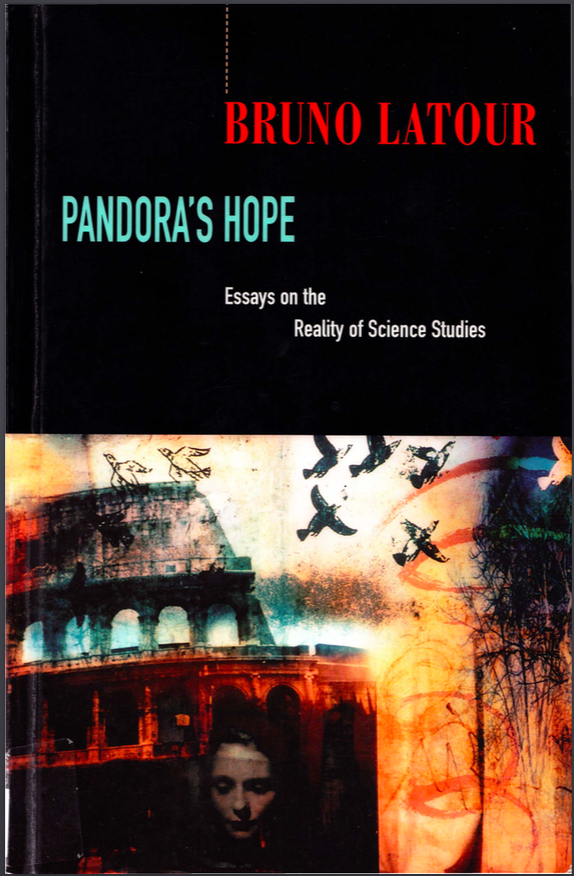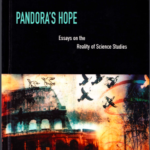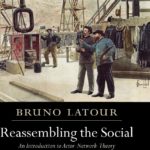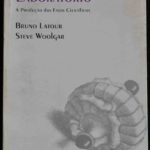
Desatando o nó conceitual dos centros de cálculo em Latour (1999)
LATOUR, Bruno. 1999. Glossary. In: Pandora’s hope: essays on the reality of science studies. Cambridge: Harvard University Press, pp.303-11.
ACTOR, ACTANT: The great interest of science studies is that it offers, through the study of laboratory practice, many cases of the emergence of an actor. Instead of starting with entities that are already components of the world, science studies focuses on the complex and controversial nature of what it is for an actor to come into existence. The key is to define the actor by what it does – its performances – under laboratory trials. Later its competence is deduced and made part of an institution. Since in English “actor” is often limited to humans, the word “actant,” borrowed from semiotics, is sometimes used to include nonhumans in the definition. (Latour 1999:303)
ARTICULATION: Like translation, this term occupies the position left empty by the dichotomy between the object and the subject or the external world and the mind. Articulation is not a property of human speech but an ontological property of the universe. The question is no longer whether or not statements refer to a state of affairs, but only whether or not propositions are well articulated. (Latour 1999:303)
CENTER OF CALCULATION: Any site where inscriptions are combined and make possible a type of calculation. It can be a laboratory, a statistical institution, the files of a geographer, a data bank, and so forth. This expression locates in specific sites an ability to calculate that is too often placed in the mind. (Latour 1999:304)
COMPETENCE: See name of action. (Latour 1999:304)
CONCRESCENCE: A term employed by Whitehead to designate an event without using the Kantian idiom of the phenomenon. Concrescence is not an act of knowledge applying human categories to indifferent stuff out there but a modification of all the components or circumstances of the event. (Latour 1999:305)
CONTEXT, CONTENT: Terms borrowed from the history of science to situate the familiar puzzle of internalist vs. externalist explanations in science studies. (Latour 1999:305)
EVENT: A term borrowed from Whitehead to replace the notion of discovery and its very implausible philosophy of history (in which the object remains immobile while the human historicity of the discoverers receives all the attention). Defining an experiment as an event has consequences for the historicity of all the ingredients, including nonhumans, that are the circumstances of that experiment (see concrescence). (Latour 1999:306)
HISTORICITY: A term borrowed from the philosophy of history to refer not just to the passage of time – 1999 after 1998 – but to the fact that some thing happens in time, that history not only passes but transforms, that it is made not only of dates but of events, not only of intermediaries but of mediations. (Latour 1999:306)
INSCRIPTION: A general term that refers to all the types of transformations through which an entity becomes materialized into a sign, an archive, a document, a piece of paper, a trace. Usually but not always inscriptions are two-dimensional, superimposable, and combinable. They are always mobile, that is, they allow new translations and articulations while keeping some types of relations intact. Hence they are also called “immutable mobiles,” a term that focuses on the movement of displacement and the contradictory requirements of the task. When immutable mobiles are cleverly aligned they produce the circulating reference. (Latour 1999:306-7)
INSTITUTION: Science studies has devoted much attention to the institutions that make possible the articulation of facts. In common usage, “institution” refers to a site and to laws, people, and customs that continue in time. In traditional sociology, “institutionalized” is used as a critique of the poor quality of overly routinized science. In this book the meaning is thoroughly positive, since institutions provide all the mediations necessary for an actor to maintain a durable and sustainable substance. (Latour 1999:307)
INTERNALIST EXPLANATIONS, EXTERNALIST EXPLANATIONS: In the history of science these terms refer to a largely obsolete dispute between those who claim to be more interested in the content of science and those who focus on its context. Although this distinction has been used for decades to settle the relations between philosophers and historians, it has been totally dismantled by science studies because of the multiple translations between context and content. (Latour 1999:307)
MATTER OF FACT: The general drift of science studies is to make matters of fact not, as in common parlance, what is already present in the world, but a rather late outcome of a long process of negotiation and institutionalization. This does not limit their certainty but, on the contrary, provides all that is necessary for matters of fact to become indisputable and obvious. To be indisputable is the end point, not the beginning as in the empiricist tradition. (Latour 1999:307)
MEDIATION vs. INTERMEDIARY: The term “mediation,” in contrast with “intermediary,” means an event or an actor that cannot be exactly defined by its input and its output. If an intermediary is fully defined by what causes it, a mediation always exceeds its condition. The real difference is not between realists and relativists, sociologists and philosophers, but between those who recognize in the many entanglements of practice mere intermediaries and those who recognize mediations. (Latour 1999:307)
NAME OF ACTION: An expression used to describe the strange situations – such as experiments – in which an actor emerges out of its trials. The actor does not yet have an essence. It is defined only as a list of effects – or performances – in a laboratory. Only later does one deduce from these performances a competence, that is, a substance that explains why the actor behaves as it does. The term “name of action” allows one to remember the pragmatic origin of all matters of fact. (Latour 1999:308)
NONHUMAN: This concept has meaning only in the difference between the pair “human-nonhuman” and the subject-object dichotomy. Associations of humans and nonhumans refer to a different political regime from the war forced upon us by the distinction between subject and object. A nonhuman is thus the peacetime version of the object: what the object would look like if it were not engaged in the war to shortcut due political process. The pair human-nonhuman is not a way to “overcome” the subject-object distinction but a way to bypass it entirely. (Latour 1999:308)
PERFORMANCE: See name of action. (Latour 1999:308)
PHENOMENON: In Kant’s modernist solution, a phenomenon is the meeting point of things in themselves – which are inaccessible and unknowable but whose presence is necessary to avoid idealism – and the active involvement of reason. None of these features is kept in the notion of proposition. (Latour 1999:309)
PRACTICE: Science studies is not defined by the extension of social explanations to science, but by emphasis on the local, material, mundane sites where the sciences are practiced. Thus the word “practice” identifies types of studies that are exactly as far from the normative philosophies of science as they are from the usual efforts of sociology. What has been revealed through the study of practice is not used to debunk the claims of science, as in critical sociology, but to multiply the mediators that collectively produce the sciences. (Latour 1999:309)
PROPOSITION: I do not use this term in the epistemological sense of a sentence that is judged to be true or false (for this I reserve the word “statement”), but in the ontological sense of what an actor offers to other actors. The claim is that the price of gaining analytical clarity – words severed from world and then reconnected by reference and judgment – is greater and produces, in the end, more obscurity than granting entities the capacity to connect to one another through events. The ontological meaning of the word has been elaborated by Whitehead. (Latour 1999:309)
REFERENCE, REFERENT: Terms from linguistics and philosophy that are used to define, not the scenography of words and the world, but the many practices that end up in articulating propositions. “Reference” does not designate an external referent that will be meaningless (that is, literally without means to achieve its movement), but the quality of the chain of transformation, the viability of its circulation. “Internal referent” is a term from semiotics to mean all the elements that produce, among the different levels of signification of a text, the same difference as the one between a text and the outside world. It is connected to the notion of shifting. (Latour 1999:310)
SETTLEMENT: Shorthand for the “modernist settlement,” which has sealed off into incommensurable problems questions that cannot be solved separately and have to be tackled all at once: the epistemological question of how we can know the outside world, the psychological question of how a mind can maintain a connection with an outside world, the political question of how we can keep order in society, and the moral question of how we can live a good life – to sum up, “out there,” “in there,” “down there,” and “up there.” (Latour 1999:310)
SHIFTING IN, SHIFTING OUT, SHIFTING DOWN: Terms from semiotics to designate the act of signification through which a text relates different frames of reference (here, now, I) to one another: different spaces, different times, different characters. When the reader is sent from one plane of reference to another, it is called shifting out; when the reader is brought back to the original plane of reference, it is called shifting in; when the matter of expression is entirely changed, it is called shifting down. These shifts result in the production of an internal referent, a depth of vision, as if one is dealing with a differentiated world. (Latour 1999:310-1)
SUBSTANCE: This word designates what “lies beneath” properties; science studies has not attempted to do away with the notion of substance altogether but to create a historical and political space in which newly emerging entities are slowly provided with all their means, all their institutions, to be slowly “substantiated” and rendered durable and sustainable. (Latour 1999:311)
TRANSLATION: Instead of opposing words and the world, science studies, by its insistence on practice, has multiplied the intermediary terms that focus on the transformations so typical of the sciences; like “inscription” or “articulation,” “translation” is a term that crisscrosses the modernist settlement. In its linguistic and material connotations, it refers to all the displacements through other actors whose mediation is indispensable for any action to occur. In place of a rigid opposition between context and content, chains of translation refer to the work through which actors modify, displace, and translate their various and contradictory interests. (Latour 1999:311)
TRIALS: In their emerging state, actors are defined by trials, which can be experiments of various sorts in which new performances are elicited. It is through trials that actors are defined. (Latour 1999:311)





 O LaSPA é sediado no Instituto de Filosofia e Ciências Humanas (
O LaSPA é sediado no Instituto de Filosofia e Ciências Humanas (